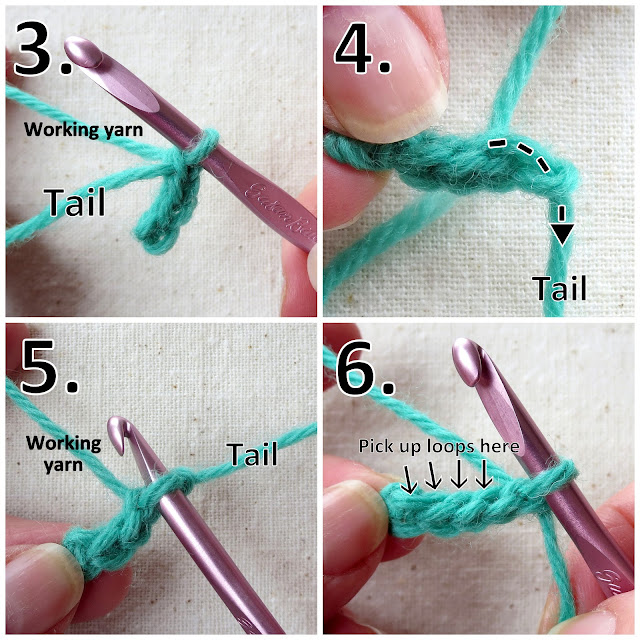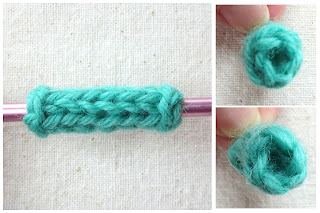The techniques in this series were developed for I-cord made with a hook, but many of them can be adapted to I-cords made by other methods.
~ ~ ~
Welcome back to our series on making I-cord with a crochet hook. Here’s what we’ve covered so far:
Part 1 - Three techniques for making a Better Basic I-cord: Longtail Cast On, Afterthought Column, and Loop-by-Loop Bind Off.
Part 2 – Self-Buttoning I-cord
Today we’ll learn how to make open-ended I-cord with tidy, invisibly-joined ends:
 |
| Which is the start and which is the end? Even I can't tell. |
Open-Ended I-Cord
Open-ended I-cord makes a great channel for drawstrings – think adjustable cowls, drawstring bags, or sweater necklines. Almost any cast on/bind off combination will work for open-ended I-cord; the method I'm presenting here was developed to yield a firm standalone I-cord with sturdy, matching ends.
This tutorial is for a 5-stitch cord. As always, you can adjust the numbers to suit your preferences.
Instructions are written for right-handed crocheters.
What you’ll need:
Yarn (non-slippery is best, worsted weight or larger)
Hook
Yarn needle for weaving in
Optional: Extra hook two or three sizes smaller (for hooking up Afterthought Column)
Optional: Stitch marker
Links to tutorials for techniques used in this post:
Knotless Longtail Cast On (scroll down in post)
Working the I-cord Body (scroll down in post)
Afterthought Column for I-Cord (scroll down in post)
Invisible Join
Open End Start
1-2. Leaving an 8” yarn tail, *
knotless longtail cast on 1 (2 loops now on hook), draw second loop through first (1 loop now on hook). Keep a relaxed stitch tension.
3. Repeat from * 3 more times (4 cast on/cast off chains complete).
4. Remove hook from working loop; with hook, draw yarn tail through working loop as though tying off, but do not tighten.
5-6. With yarn tail facing right, insert hook under back bump formed by yarn tail (Photo 5), draw up a loop with working yarn (Photo 6). Tug yarn tail to secure.
Take a moment to look at your starting row: one long edge looks like traditional chain stitches, and the opposite edge looks like knitted garter stitches.
Hold the starting row with the "chain" edge facing you, angled slightly downwards, as in Photo 6. You'll be picking up loops in the yarn strands just behind the chain edge.
7. *Keeping working loop on hook, insert hook through strand just behind the back loop of next chain (indicated by rightmost arrow in Photo 6 above), draw up a loop.
Repeat from * across – 5 loops on hook.
Not pictured: Remove hook from loops; insert hook into
second loop from the right, leaving the rightmost loop hanging. I-cord will be worked over the 4 remaining loops (indicated by arrows in Photo 7).
8. Work
I-cord body rows to desired length,
leaving the hanging loop unworked.
Not pictured: Use yarn loop or stitch holder to temporarily secure top loops.
Inserting hook from bottom to top of hanging loop, hook up the
afterthought column.
Open End Bind Off
After working Afterthought Column, remove the yarn loop or stitch marker to release the secured loops.
Remove hook from afterthought column loop.
9. Inserting hook into the loop where the running yarn is attached (this should be the next loop to the right of the afterthought column),
chain 1.
*Insert hook into next loop to the left, yarn over and draw through both loops on hook (one stitch bound off).
Repeat from * until all loops are bound off.
12-13. Cut yarn, leaving a 6” tail.
Invisible join to first bound-off stitch.
At starting end, using starting tail,
invisible join cast on stitches to form a continuous ring.
Weave in both ends.
Technical Notes
Using a combination cast on/bind off for the starting chain was the best way I could devise to set up for the Afterthought Column and have a yarn tail in the proper place to make a truly invisible join. If you know a simpler method that will give the same results, I'd love to hear about it!
If you're wondering why we chained 1 before binding off: I-cord is worked in a spiral, which means the starting loop of a round will always be lower than the ending loop of a round. (The Afterthought Column loops are technically the ending loops of each round.) Adding a chain-1 brings the starting loop level with the ending loop, and makes for a smoother invisible join.
(It's all about the invisible join....)
~
And that's it! Shortest tutorial of this series so far. :)
You may do whatever you like with any items you make using this tutorial, but you may not distribute the tutorial, its text, or images, without permission. (Links are always welcome.)
In the next segment, we'll learn how to invisibly graft I-cord into a continuous-looking loop. After that, we'll tackle using I-cord as foundation and finishing edges for crochet.
Until then, happy crocheting and I-cording!
~ ~ ~ ~ ~ ~ ~ ~ ~ ~ ~ ~









